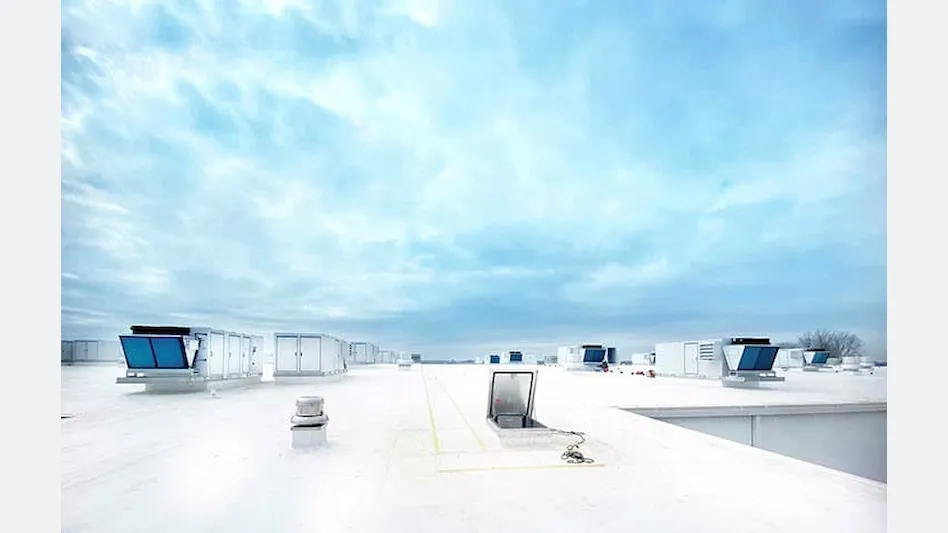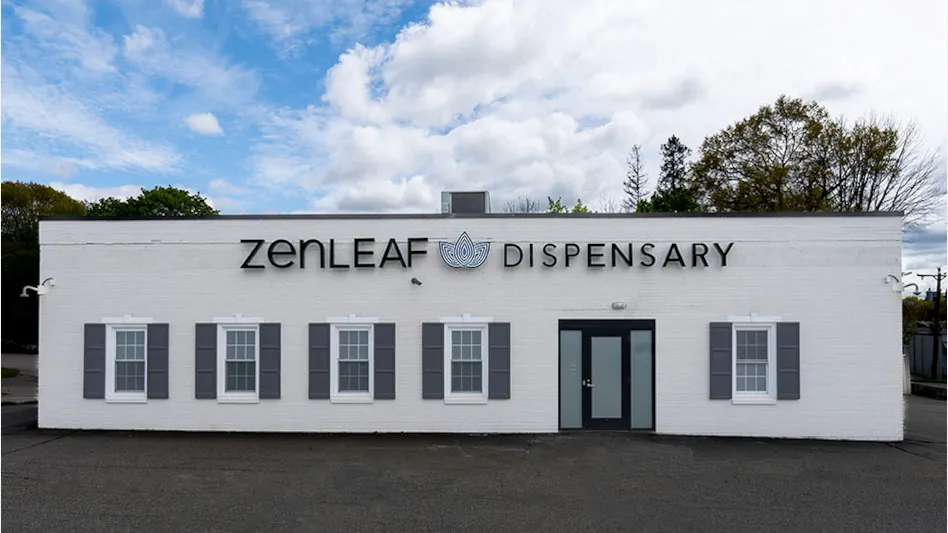
Courtesy of Quest
Reliable heating, ventilation and air conditioning (HVAC) equipment can cost upward of $300,000 or more for a 5,000-square-foot growing facility in the cannabis space. Proper lighting might cost just as much.
But those environmental controls become less effective for an ideal harvest if they are not complemented by the intelligent application of air distribution through engineered ductwork, which isn’t overly complicated nor expensive in the grand scheme of a productive room, according to Geoff Brown, vice president of technical solutions for Quest.
Often an afterthought, airflow is currently the biggest hump for growers in relation to environmental controls, but it doesn’t have to be, Brown said. Through Quest’s partnership with Hawthorne Gardening Company, growers now have access to the Airflow Mapping service, a computer-aided analysis that calculates or predicts where a diffuser’s air will travel. In turn, growers have access to custom solutions to their specific facilities without making major changes to those facilities.
Featured here, Brown shares more about Airflow Mapping, the importance of intelligent air distribution, working with manufacturers, return on investment and other pertinent knowledge to help avoid oversights associated with environment controls.
Q: Why is airflow so important in cannabis cultivation?
A: Ultimately it just comes down to building productive plants. TIP 1 Good air circulation at the leaf is what allows the leaf to breathe, to get rid of the oxygen around the leaf and to absorb more CO2 to make sure that the transpiration is happening and that you don’t have a locally deficient vapor pressure deficit (VPD). It’s really how the system needs to work. In my opinion, airflow is the single most overlooked thing in cannabis right now, or at least it is the next hump to get over.
The hump 10 years ago was, “Oh, shoot, we’re going to put cooling units in these rooms and hopefully they’ll do enough for dehumidification.” And then there was a dehumidification problem. Now there’s a notion, “We’re putting cooling units and dehumidifiers in, so we don’t have to think about airflow.”
So, how has that been addressed? Well, people have thrown in rotation fans in the space to move air around, but there’s no real concerted effort at managing airflow, or at least thinking intelligently about how airflow works in your room. It’s an afterthought at best.
TIP 2 Proper engineered ductwork is relatively inexpensive in the grand scheme of indoor grow rooms. A 5,000-square-foot, which is a big room, and a productive room, might cost $20,000 in ductwork. And properly designed ductwork reduces the need for air-rotation fans in the space.
TIP 3 Air-rotation fans, although they’ve been used successfully, are actually a really bad thing for an efficient growth. For one, every watt they consume is an additional watt that needs to be removed from the space by a cooling system. So, you pay to run the fan and then you pay to cool off the fan. And most of those fans are also relatively inexpensive, open-pole motors. They can’t be cleaned properly between grows. So, you end up with either a vector for infection in your space or a fan that’s a pain to clean. The bottom line is it’s not a good use of resources, it’s not sustainable, and there’s a better way to manage it.
Q: What exactly is the Airflow Mapping service that Quest and Hawthorne have partnered to offer indoor operators?
A: Airflow Mapping is basically using computer-aided design to calculate or to predict where each airflow stream, or where each diffuser’s air will go. It uses things like internal duct pressure and velocities and volumes to predict or map out very accurately what the airflow in the space is going to look like. It truly creates an airflow map in the space. Typically, those are presented as velocity maps.
TIP 4 Roughly 5 feet per second is the ideal speed through the canopy, and Airflow Mapping shows very easily what your duct concept is going to give you in terms of overall rotation in the space. It’s a relatively inexpensive way to do your duct design and to test your duct design without needing to sacrifice a million-dollar room.
Q: Is Airflow Mapping a one-time analysis, or are there certain components installed that provide continual, live readings?
A: Airflow Mapping is a completely computerized analysis. The Quest IQ systems are designed as constant velocity and volume systems. So, Airflow Mapping day one versus day 50 versus harvest day, the only change is the height of the canopy. TIP 5 There are only a couple of different models that need to be done to accurately reflect what’s happening in any given room.
Typically, you’ve got an engineer who has designed ductwork systems, who has laid out his or her best estimate or best experience of what that ought to look like. We run it through the Airflow Mapping tool and then are able to either tweak the engineer’s design or strategically apply air-rotation fans to hit trouble spots instead of relying on them for the entire room.
TIP 6 That’s typically what we’re doing, is we’re looking at that design and saying, “Yes, this is reasonable. It’s not going to cost too much money to fix that particular corner. So, let’s apply in our rotation fan, but let’s de-stratify that one particular problem area and move on with our lives.” It allows us to do that without sacrificing a plant, or having a bad harvest, or having powdery mildew developed in the corner because it’s a stratified air mass. These are the kinds of things that we can determine in the computer, and map out in the computer, prior to a grower running the facility.
Q: The Airflow Mapping modeling software is the same software used by NASA engineers to design space shuttles—is that what makes the service groundbreaking to the industry?
A: Absolutely. Software like that has existed for a long time, but it has typically been reserved to agencies like NASA using it to determine the heating of individual tiles on a space shuttle at reentry, or velocities over individual parts of the ship. So, the technology itself is not new, but its application in anything other than specialized military projects or NASA is new and has become more of a commonplace in the past few years among high-performing organizations that have brought the software to the prosumer market.
Q: The Airflow Mapping basically helps indoor growers with custom solutions to their specific facilities without making major changes to those facilities, correct?
A: Exactly. TIP 7 Airflow Mapping is able to quickly identify potential problem areas that are much easier to change in the design phase than after everything is installed and after you’re stepping on the master grower to make ductwork changes in a space.
Q: What’s the importance of good ductwork to achieve an ideal airflow?
A: It’s not just a matter of putting up whatever ductwork happens to be cheaper or fell off your sheet metal guy’s truck. TIP 8 Real ductwork with good diffusers, getting the right flow, and getting the right throw out of your diffusers and out of your duct design is crucially important. So, it really does need to be an engineered system to do that properly.
Right now, there’s a lot of interest in things like fabric ducts because they’re quick and easy to put up. They’re quick and easy to take down and launder between grows, if you ever need to. TIP 9 But even something like that duct, you can get real air devices in it. You can get real diffusers with long-throw devices or high-velocity patterns that get air in the right spot. That is very important.
TIP 10 That’s only useful if you have enough airflow out of your HVAC system to make it work. That’s where with Quest IQ handling the entire needs of the space, the heating, cooling and dehumidification of the space in one unit, we run a higher than typical airflow than you would out of a rooftop package cooling unit, for instance. The extra airflow plus good duct design means that we’re able to get the canopy movement and get the penetration into canopy to get the real leaf movement that we’re looking for without requiring the use of some of the band-aids that have been put in previously, like air-rotation fans.
Q: When it comes to tracking the canopy velocity, is it ideal for airflow to be moving horizontally, vertically or both?
A: Like anything, it depends. TIP 11 It’s going to depend on the type of grow, the type of lights and the tiering of it. We’re seeing a lot more multi-tiered rows—two, three, four levels sometimes—particularly with LED lights being more common and not dealing with quite as many heat issues as the market has previously. That’s going to affect where air distribution is effective.
Also, getting the air in the right spot is important. It can be difficult sometimes with a typical grow room, 14 feet tall, and you’ve got a supply grill on the roof and your return is up top, because your equipment is on the roof. It can be hard sometimes to get the air down low. TIP 12 That’s where a good air device with the right amount of throw to get the air to the canopy matters.
In my perfect world, TIP 13 I would love to see supply and return happen opposite each other. So, if you’re going to supply high and pull air down through the canopy, your return would be low to help that, to not have as much opportunity for stratification, or vice versa, right? If you’re going to supply low, which some people do, they supply into the under-table ductwork or something like that, and then pull or draw air up through the canopy to have a high return, that’s going to be situational. Sometimes it’s just growers get shoehorned into things because they’re retrofitting an existing building. They’re not building a facility from scratch; it’s what is available to them.
Regardless of what is available to them, the Airflow Mapping can help them determine the best way to lay out that airflow pattern. Whether it’s a high supply, low return, or whether they’re forced to do a high supply, high return and would naturally have some stratification problems, we can help mitigate that through the Airflow Mapping.
I’m not sure that I’m comfortable putting my hat in the horizontal versus vertical versus both. TIP 14 I think all of them can be applied properly with some intelligent thought.
Q: What other oversights do cultivation facilities make when it comes to airflow?
A: One is that example of high return, high supply. If you were to look over your head right now, if you’re in your office, you’d probably see one of those four-way supply grills. They have no throw and they’re not designed to, because they’re designed to get air from a 9-foot ceiling down to a 6-foot breathing space.
We often see rooms that have those same style of diffuser in a 14-to-16-foot-high room and high supply. TIP 15 Issues like that are going to naturally cause stratification, where you’ve got a high supply, you’ve got high return. You don’t have a good air device. You’ve got your lights that sort of naturally create a bit of an umbrella or barrier to the air dropping down low. You may have horizontal air-rotation fans giving you a bit of an air curtain. And you’ve got a space that’s always going to be stratified as a result.
TIP 16 Reducing air-rotation fans can reduce your overall HVAC demand costs by something like 8% to 10% a year. So, if you’re talking about a typical room that would easily spend $50,000 a year in energy, you’re going to save $5,000 a year by doing ductwork properly. It pays for itself very quickly.
Q: Do taller or bushier plants play a factor in dead-zone considerations for facilities?
A: They absolutely can, as well as moving racking. Between the two we can often end up with situations with a bit of an aisle effect, where air doesn’t penetrate well into the canopy and will naturally go where there’s less air resistance. TIP 17 If you’ve got moving racking where you’re no longer working in the room and your rack home position changes on a daily basis, or changes versus where the ductwork was designed, you can end up with a situation where the air isn’t going into the canopy the way it ought to and instead is finding the easy path.
That can happen as well with bigger or bushier cultivars, or cultivars with thicker canopies. It absolutely can be harder to get air into the canopy. TIP 18 That’s where an intelligent application of under-canopy ductwork may make more sense, where you draw air up through the canopy in a vertical way instead of trying to push it from the side on an angle. But that’s quite application-specific. It’s really going to depend on the cultivar that you’re trying to grow.
Q: How can a grower with movable racking avoid airflow problems?
A: Movable racking is becoming very common, of course, TIP 19 but home positions for that racking are not always well-respected and can absolutely cause problems if you’ve got an engineered system and then you change some aspect of the system, like where the plants are. You can certainly have a negative impact on your airflow there.
There is an education piece in ensuring that the person in the room who’s working on the plants understands the impact of maybe not quite following standard operating procedure and not returning the rack to the right spot because, “Who cares if it’s a rack in the same room; what does it matter?”
I’m a big proponent of process improvement overall, TIP 20 but a big part of process improvement is knowing the why and having everybody know and understand why something is being done, not just, “Those are the rules, so do it.” Understanding why the racks need to be in the right spot when you leave the room matters.
Again, I just think air distribution generally is the biggest problem facing this industry. It’s the one that’s most ripe for some good education right now.
Latest from Cannabis Business Times
- South Dakota Group Submits 29K Signatures for 2024 Adult-Use Cannabis Legalization Measure
- Rescheduling Would Have Saved Verano $80M in 2023 Tax Payments, CEO Says
- Aurora Marks 1st Medical Cannabis Shipment to New Zealand Market
- Where All 100 US Senators Stand on SAFER Banking Act
- Blumenauer Unveils Legislative Blueprint, Additional Administrative Action Needed Following Rescheduling
- Cannabis Rescheduling FAQ: What Now?
- From Custodian to Cultivation Supervisor
- California City in Cannabis Retail Desert Welcomes 1st Dispensary





